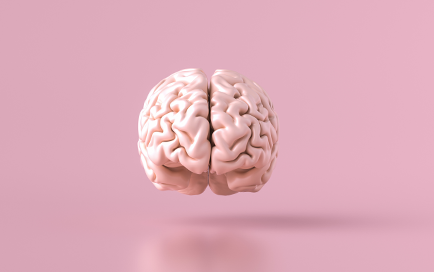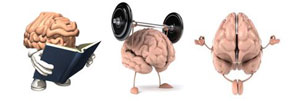
INTRODUCTION
There are significant opportunities for OTC marketers in the area of brain health. This is an area of serious concern for many individuals who either have the disease or wish to avoid succumbing to it. Current prescription drugs offer treatment for individuals with advanced levels of dementia and Alzheimer’s disease, with mixed results. However, many consumers, seeing first-hand results of brain disease in elderly parents and relatives, are eager to maintain their own brain health and prevent or delay the onset of dementia or Alzheimer’s disease.
Currently, in the nonprescription spectrum of the market, there are a handful of nutritional supplement brands aimed at brain health, but this area remains largely under served by the OTC industry. There are OTC brands that make claims for heart health, joint health, and even prevention of heart attack, so why not claims for brain health? This paper examines the current landscape of brain health and fleshes out opportunities for OTC marketers to consider.
BRAIN HEALTH: THE ISSUE
Dementia
As individuals age, the size of the brain gradually decreases and blood flow within the brain also decelerates. As a part of the normal aging process, individuals are less flexible, both physically and mentally. Occasional memory lapses are common as certain nerve cells shrink or lose connections with other nerve cells. However, significant memory loss and other cognitive symptoms that affect everyday activities are not considered normal.
Dementia is an umbrella term that describes the symptoms that take place when the brain is affected by certain diseases or conditions, as described in Figure 1. The mental decline in dementia is severe enough to disrupt routine activities and affects one of the four core brain functions: recent memory, language, visual/spatial function, and executive function, which includes memory, reasoning, problem solving, and other cognitive processes.
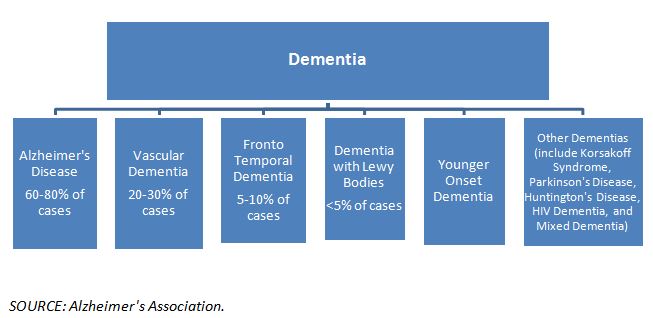
While there are fundamental differences between industrial and consumer markets, the branding concept remains the same: determine the best brand message and communicate this to all audiences, both internal and external. When a product-centric approach becomes ineffective, a high-impact branding strategy can lead to significant competitive advantages (including internal benefits) for those with a well-defined, well-articulated, and well-managed brand strategy.
Without it, industrial lubricant marketers could be leaving money on the table by failing to maximizing the investments made in developing superior products.
Alzheimer’s disease
As the baby boomer population continues to age in the United States, the number of people with Alzheimer’s disease is likely to increase. According to April 2014 data from the U.S. Census Bureau, there are currently 76.4 million baby boomers in the United States. The Census Bureau estimates that individuals above the age of 65 will total 98.2 million by 2060.
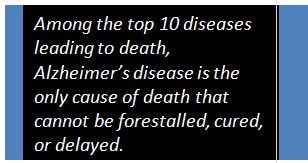
Alzheimer’s disease is the sixth leading cause of death in the United States. As shown in Figure 2, an astonishing 82.9% of deaths in the 85+ age group are from Alzheimer’s disease. Among the top 10 diseases leading to death, Alzheimer’s disease is the only cause of death that cannot be forestalled, cured, or delayed. Several researchers are employing imaging technologies to indicate that the disease progressively destructs personalities and yet it remains irreversible. Available Alzheimer's disease treatments cannot halt the disease from progressing and can only temporarily slow progression of symptoms. As of 2015, approximately 5.3 million Americans of all ages have Alzheimer's disease, and of this total 96.2% or roughly 5.1 million people are aged 65 and above. Of the people aged 65 and older with Alzheimer's disease in the United States, 3.2 million diagnosed or 62.8% are women. African American and Hispanic Americans are more likely to develop Alzheimer’s disease than Caucasian Americans.
Figure 2: Alzheimer’s Death Rate per 100,000 by Age in the United States, 2013
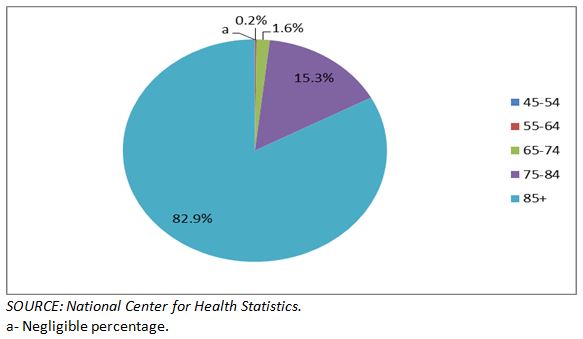
According to the Alzheimer’s Foundation of America in 2014, friends and family of patients suffering from Alzheimer's disease and other dementia rendered approximately 17.9 billion hours of unpaid care. Providing care for family members with Alzheimer’s disease takes a toll on the caregivers’ health and well being. Nearly 60.0% of Alzheimer’s disease and dementia caregivers rate the emotional stress of caregiving as high or very high and around 40.0% of caregivers suffer from depression. Alzheimer’s disease and dementia caregivers had $9.7 billion in additional healthcare costs of their own in 2014 due to the toll of care giving to Alzheimer’s disease patients.
Projections for Alzheimer’s disease and dementia incidence in the United States and globally
According to the Centers for Disease Control and Prevention, the number of people living with Alzheimer’s disease is likely to triple during the next 35 years due to the aging population. Figure 3 illustrates the rapid expected growth of the aged 65+ population. Current prescription medications for Alzheimer’s disease or dementia are expensive and provide support only for a limited period of time. Cognitive decline is a major concern of the aging baby boomer population. Studies indicate women's brains to be more vulnerable to Alzheimer's disease and other problems with memory and thinking in comparison to men. Women with mild cognitive impairment, which can lead to Alzheimer's disease, are likely to decline faster than men.
Figure 3: Number of Persons 65+, 1900 to 2060 (Number in Millions)
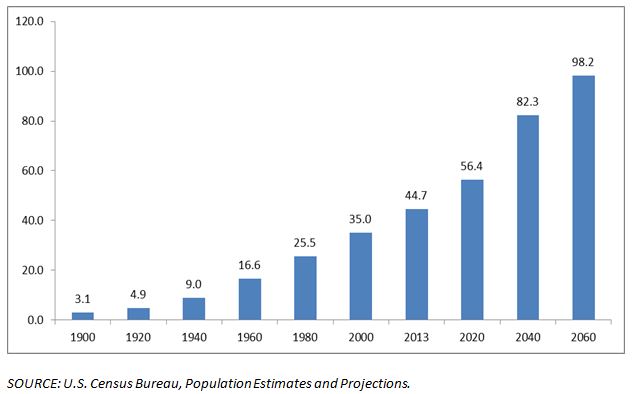
In 2015, the direct costs to American society of caring for those with Alzheimer's will total an estimated $226 billion, with half of the costs borne by Medicare. Unless something is done, in 2050, Alzheimer's is projected to cost over $1.1 trillion (in 2015 dollars)(1). There is a sizable opportunity to shift the costs of care to treatments that prevent or cure cognitive decline.
Globally, approximately 44 million people have Alzheimer’s disease or related dementia. According to Alzheimer’s Disease International, approximately only one-in-four individuals experiencing Alzheimer’s disease have been diagnosed. The global distribution of dementia varies according to the cultural and the socioeconomic differences among nations. The prevalence of dementia is higher in the developed nations in comparison to the developing nations. The difference in the risk prevalence can be attributed to the level of exposure to cerebrovascular risk factors, such as hypertension, smoking, obesity, and diabetes. A greater availability of accessible health care in developed nations may also contribute to the higher incidence rate, as a larger proportion of the population would be under a doctor’s care and therefore more likely to receive a diagnosis, compared to developing nations where a disease is more likely to go undetected. Given the longer life spans of residents of developed nations, the risks of developing dementia are also higher compared to residents of developing nations where residents may not live as long.
According to 2014 World Health Organization (WHO) data(2), 172 countries are ranked according to death rates due to Alzheimer’s disease per 100,000. North America (excluding Mexico), Western Europe, and Australia demonstrate the highest death rates due to Alzheimer’s disease while select regions in Africa and Brazil indicate a moderately high death rate due to the disease. Countries such as Slovakia, Zimbabwe, Kenya, Greece, Brunei, Oman, Mauritius, and Russia are categorized as having moderately low death rates due to Alzheimer’s disease. Of the 172 countries, 21 countries register less than 1 death rates due to Alzheimer’s disease or dementia, outlined in Table 2.
Several Nordic countries, including Finland, Iceland, and Sweden, have high mortality rates due to Alzheimer’s disease or dementia, as noted in Table 1. Environmental pollutants are the principal factor that result in a high incidence of the disease in these regions. The Baltic Sea, which is enclosed by Scandinavia, Finland, the Baltic countries, and the northern European plains, is one of the most polluted bodies of water on the planet, the microbes of which affect most Nordic countries. Alzheimer’s disease is a member of an aggressive family of neurodegenerative diseases known as Transmissible Spongiform Encephalopathy (TSE). TSEs are caused by a deadly protein called prion which is found in the Baltic Sea and elsewhere(3). Prions spread in an uncontrolled manner within victims and within the environment. Neurological diseases caused by prions include Alzheimer’s, Parkinson’s, Huntington’s, amyotrophic lateral sclerosis (Lou Gehrig’s disease), and other disorders known as frontotemporal dementias.

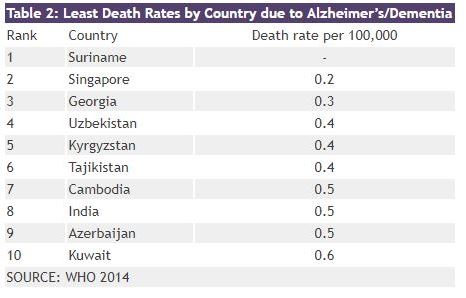
Risk factors
Age
The largest risk factor associated with Alzheimer’s disease is age. The risk of developing the disease doubles every five years after the age of 65 years. The risk of contracting the disease reaches 50.0% after the age of 85 years.
There are two types of genes that play a role in determining whether a person develops a disease: risk genes and deterministic genes. Alzheimer's disease genes have been found in both categories. Below is the list of chromosomes containing one of the three genes that cause hereditary Alzheimer's disease and the gene with the greatest impact on Alzheimer's disease risk:
- Amyloid precursor protein (APP)
- Presenilin-1 (PS-1)
- Presenilin-2 (PS-2)
- Apolipoprotein E-e4 (APOE4)
Lifestyle
The risk factors associated with dementia are high for consumers who opt for unhealthful choices, such as smoking, an unhealthy diet, and a sedentary lifestyle.
In 2014, the World Health Organization (WHO) issued a report titled “Tobacco Use & Dementia" which finds that smokers have a 45.0% higher risk of acquiring dementia in comparison to non-smokers. The report states that roughly 14.0% of all global Alzheimer's disease cases may be attributed to smoking. According to the study, smokers with dementia die sooner than non-smokers with dementia.
A few studies(4) have analyzed the link between chronic stress and dementia and indicate a positive correlation between the two factors. Some research indicates yoga and meditation can forestall and/or heal symptoms of mild cognitive impairment (MCI) and dementia and improve the quality of life for both patients and their caregivers.
There are several studies(5) that suggest a link between depression and dementia and scientists are working to uncover the reasons for a probable connection between the two. A few top theories include a link between depression which may directly impair brain cells leading to dementia and that depression may alter the size of the hippocampus, an area of your brain involved in forming emotions and memory, thereby placing such individuals at a higher risk of dementia. According to the Alzheimer’s Association, approximately 40.0% of patients suffering from Alzheimer’s disease also suffer from significant depression.
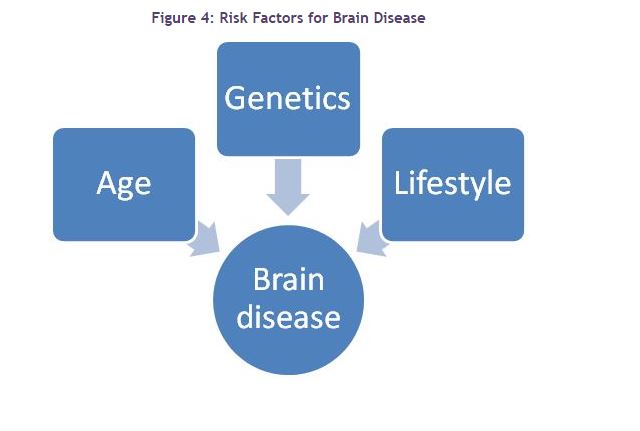
Challenges
As of 2014, in the United States Alzheimer's disease kills more people each year than a combination of people who die due to prostate cancer and breast cancer. More than 99.0% of Alzheimer’s drugs tested in clinical trials have failed. Despite an abundance of scientific research, there is no cure for Alzheimer’s disease. Scientists and researchers continue to work on multiple in an effort to make a breakthrough. The only progress made so far is with the FDA approving five prescription drugs to treat different levels of Alzheimer’s disease.
AVAILABLE TREATMENTS
Prescription medications
There are several prescription medications indicated for the treatment of Alzheimer’s disease. Drugs that make up the class of medications known as cholinesterase inhibitors include:
- Exelon (rivastigmine) by Novartis indicated for treatment of mild to moderate Alzheimer’s disease.
- Razadyne (galantamine) by Johnson & Johnson indicated for treatment of mild to moderate dementia of Alzheimer’s type.
- Aricept (donepezil) by Pfizer for treatment of all stages of Alzheimer’s disease.

Additionally, Allergan markets Namenda (memantine HCl) for the treatment of moderate to severe Alzheimer’s and this drug treats memory loss, confusion, and problems with thinking and reasoning. Allergan co-markets Namzaric with Adamas Pharmaceuticals which combines memantine with donepezil for the treatment of moderate to severe Alzheimer’s disease and was recently approved in 2014 by the U.S. FDA.
As of 2014, the FDA approved select drugs for treating various stages of Alzheimer’s disease, as listed in Table 3.

According to a study published in the journal Neurology(6), consumption of omega-3 fatty acids, commonly found in various types of fish, is likely to benefit individuals with a high risk potential of acquiring Alzheimer’s. Lovaza, a prescription drug marketed by GlaxoSmithKline and developed by Reliant Pharmaceuticals, is an FDA-approved drug for treating patients with high triglyceride levels. The drug is synthesized from fish body oils and is formulated using two main active pharmaceutical ingredients: EPA-ethyl ester and DHA-ethyl ester. In April 2014, Teva Pharmaceutical Industries announces the FDA approval of the generic equivalent to Lovaza in the United States. The drug is not indicated for the treatment of Alzheimer’s disease, but it is possible that such an indication could be added if the drug is found to have efficacy for Alzheimer’s treatment in clinical trials.
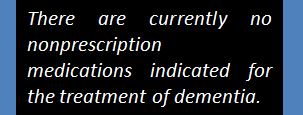
Two prescription drugs, solanezumab (Eli Lilly) and aducanumab (Biogen), are at the beginning of research in human trials and would require a minimum of two years to get through the approval process if they prove to be effective. Both drugs intend to clear amyloid plaque buildups from the brain in order to slow cognitive declines caused by Alzheimer’s disease. Initial results of clinical trials for both drugs were released on July 22, 2015, and indicate that solanezumab exhibits consistently better results when the drug is taken for a longer period of time while aducanumab yielded stronger efficacy with a higher dosage.
Over-the-counter options
There are currently no nonprescription medications indicated for the treatment of dementia or Alzheimer’s disease; however, several vitamins and ingredients are suspected in playing a role in delaying dementia and maintaining brain health including ginseng, ginkgo biloba, omega 3s, Huperazine A, amino acids, vitamins A, C, D, and E, B vitamins, and choline.
Data on various OTC brain health market segments in the United States are shown in Table 4. The market for omega 3 is sizable, but brands in this space make mostly heart health claims. The specific brain health segment of the market, while currently small has grown over 300% in the past year. From the growth over the past year it is evident that consumers are interested in taking supplements that are labeled for “brain” or “mind” health as shown by the rapid growth of the “brain health” and “mind blends” market segments.
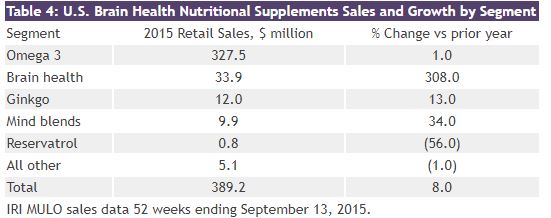
The total size of the brain health nutritional supplement market is only a fraction of the overall size of vitamin and mineral supplements category, which is valued at $6.6 billion in retail sales (IRI MULO data 52 weeks ending May 17, 2015) and grew 2.3% from the same time frame in 2014. While these sales estimates include drug, food, mass, club, and dollar stores and exclude the sizable online and health food channels, they nevertheless help illustrate the relatively nascent nature and strong growth potential of the brain health market.
Companies market supplements that claim to enhance memory and delay age-related cognitive decline. There are several “memory supplements” with claims of being formulated using a combination of vitamins, herbs, amino acids, fats, and other nutrients. However, the two primary ingredients in these memory supplements include acetyl-l-carnitine and phosphatidylserine. Acetyl-l-carnitine is an amino acid with attested brain-boosting and anti-aging properties and is purported to improve alertness, focus, mental clarity, and mood. Studies have documented phosphatidylserine to boost memory, cognition, concentration, and learning as it normalizes the stress hormone cortisol and helps to reduce stress. Some brain health/memory enhancing supplement brands are shown in Table 5.

Sales data and growth rates for select supplements are shown in Table 6. While these brands are small compared to other supplement/OTC brands, the rates of growth for these supplements are significant, which signals that consumers are seeking prevention options for brain health. White space opportunity clearly exists in brain health. OTC or nutritional supplements that claim to prevent dementia/memory loss and help maintain brain health will be increasingly well-received by consumers across multi generations who want to take a proactive approach to helping themselves in this important aspect of their health.

LOOKING AHEAD
Since there is currently no cure for dementia, OTC marketers are advised to focus on developing and marketing preventive solutions that delay or lower the risk of the disease. Several studies have been and are being conducted in an effort to determine if certain natural and supplement ingredients are correlated to a reduction in the risk of developing Alzheimer’s disease. Details on research related to some ingredients are described in Figure 5.
Figure 5: OTC and Nutritional Ingredients and their Link to Reduced Risk of Cognitive Decline
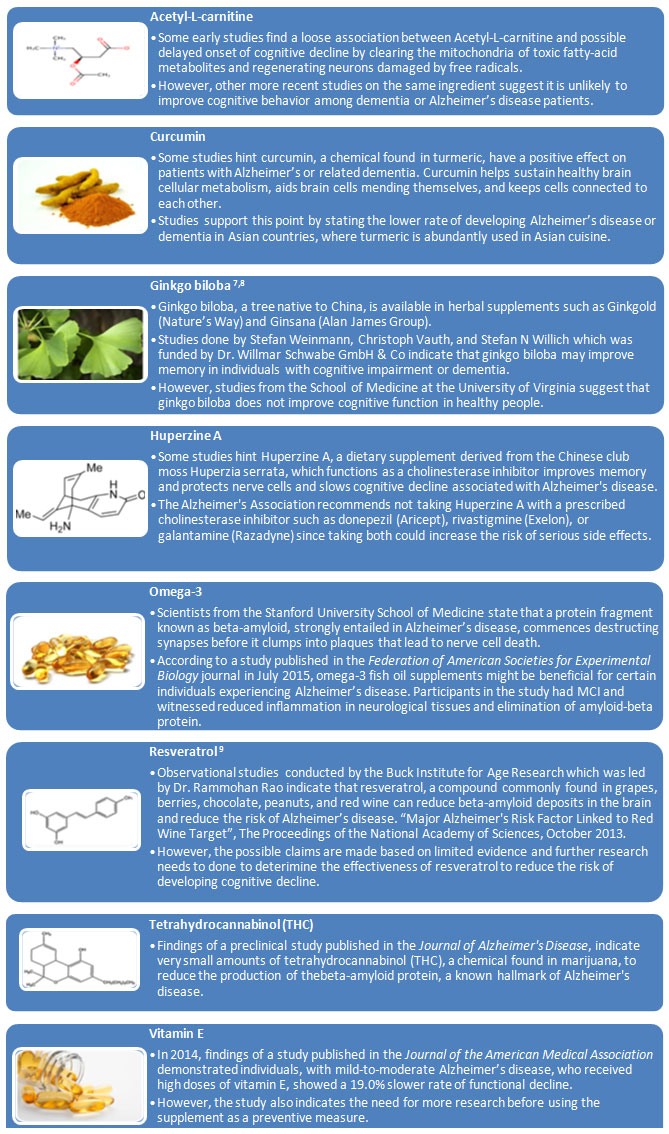
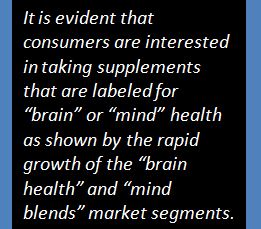
Scientists and researchers are also in the process of developing tests to detect symptoms of Alzheimer’s disease or related dementia much before memory decline manifests itself. So far, no test can forecast the risk or determine the progression rate of the disease in a precise manner.
Americans of all generations are concerned about cognitive decline and many are adjusting diets, increasing physical activity, and challenging intellectual abilities in an effort to maintain and preserve brain health(10). While the baby boomer population may be the chief target for such products or services, OTC marketers can also effectively tap Generation X and millennials. According to the Census Bureau data analysis, millennials are likely to surpass baby boomers as the largest generation alive by 2028.
Successful marketers will integrate digital media and mobile applications to effectively engage with consumers of all ages by helping them live healthy lifestyles and support their brain health. For example, a brand could offer an app that integrates content about brain health, a cognitive memory game, monitors risk factors like stress and fitness, and information about their product offering. Currently there are many digital offerings addressing brain health such as Fit Brains by Rosetta Stone, shown in Figure 6, CogniFit Brain Fitness app, and InteraXon’s Muse Brain Sensing Headband, but few, if any, are integrated with treatment options.
Figure 6: Digital Brain Health: Fit Brains by Rosetta Stone

Conclusions and recommendations
There is significant upside market potential in the area of brain health, which remains a largely untapped OTC market with meaningful treatment gaps even in the prescription market as well. Opportunities exist for OTC products that are specifically marketed to preserve, support, and maintain brain health. Many consumers are eager to maintain their own brain health and prevent or delay the onset of dementia or Alzheimer’s disease.
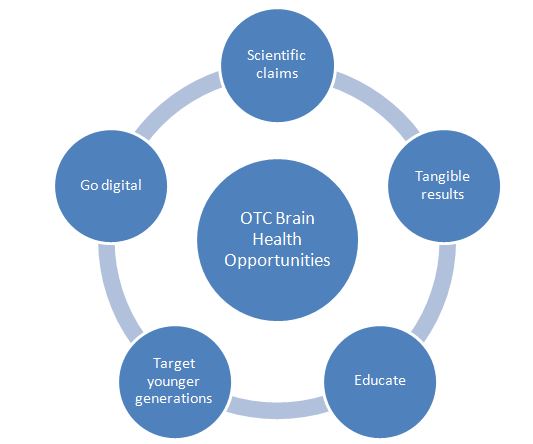
Companies that educate consumers on product ingredients, efficacy, and safety can benefit from this burgeoning category. The most successful brands in this space will make specific claims backed by solid, scientific evidence that can demonstrate tangible results. Companies whose clinical trials produce products or claims that can be patented or gain market exclusivity are likely to enjoy success, although this is not an absolute requirement for success in this category. White space opportunity exists that OTC marketers can fill in brain health because demand is critical with a high number of consumers seeking solutions which are not adequately addressed by currently available OTC or prescription drugs. OTCs/nutritional supplements can bridge the gap with products aimed at prevention of dementia/memory loss and that help maintain brain health. There is ample evidence such products will be increasingly demanded by consumers across multiple generations who want to take a proactive approach to helping themselves in this important aspect of their health.
References
(1) Alzheimers’ Association.
(2) www.worldlifeexpectancy.com”, WHO Publish Date, May 2014.
(3) “Alzheimer’s Disease Surging In Baltic States” (Gary Chandler), alzheimerdisease.tv, June 2015.
(4) “How chronic stress accelerates Alzheimer's disease” (Sara K. Bengtsson), Umea University, March 2013.
(5) “Depression could be separate risk factor for dementia” (research led by Rush University Medical School), Neurology, July 2014.
(6) “Eating Omega-3s May Help Reduce Alzheimer’s Risk” (researchers from Columbia University Medical Center in New York), Neurology, May 2012.
(7) “Ginkgo biloba for Prevention of Dementia: A Randomized Controlled Trial” (ST DeKosky), The Journal of the American Medical Association, November 2008.
(8) “Effects of Gingko biloba supplementation in Alzheimer's disease patients receiving cholinesterase inhibitors: data from the ICTUS study” (M Canevelli), Phytomedicine, May 2014.
(9) “Major Alzheimer's Risk Factor Linked to Red Wine Target” (researchers from the Buck Institute), The Proceedings of the National Academy of Sciences, October 2013.
(10) “Aging Americans work to keep dementia at bay with healthy eating and brain teasers”(Kelsey Dallas), NEWSOK, July 2015
